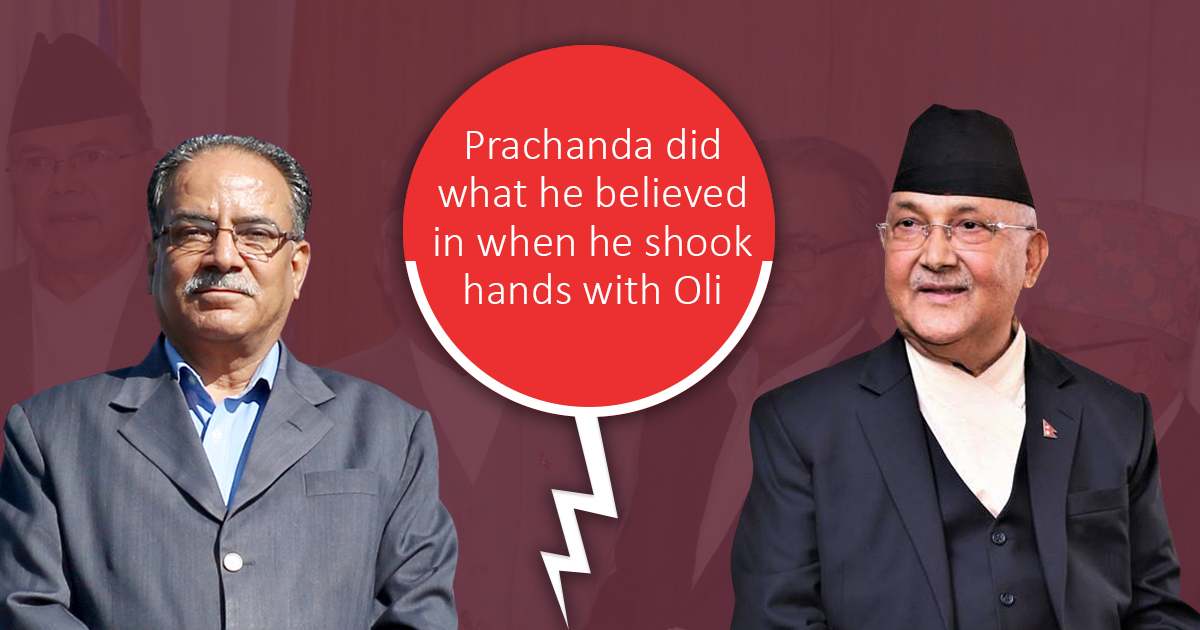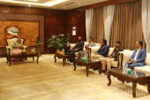When Chairperson of the then CPN-Maoist (Center) Pushpa Kamal Dahal tabled a no-confidence motion against the then Prime Minister K P Oli on 24 July 2016, PM Oli then had claimed his stake to become the country’s Prime Minister once again.
Giving his emotional, yet witty speech at the parliament, K. P. Oli had spoken a literary piece quoting Aruna Lama, a Nepali singer, which underscores well the relationship between the two leaders. Amongst other things, K. P. Oli then alluded Dahal to be a man who is a spoiler to soil himself and others by throwing muds not knowing it will expose all to troubles, he tears the things apart and Oli projected himself as a man who mends the fences and brings the things together which are falling apart.
Oli quoted Aruna Lama to score political brownie points against Dahal. They were fierce political competitors then decided to join hands out of a sudden after 15 months on 3 October, 2017 to have a pre-poll alliance and merging two political parties CPN-UML and CPN-Maoist (Center) to create a new one which they appear to have done somehow as Nepal Communist Party.
Prachanda is fond of saying, “Politics is the game of possibility and nothing is impossible in politics.” Prachanda did what he believed in when he shook hands with Oli to explore and exploit the political fortunes with him. The pre-poll alliance between the two parties posted extra-ordinary win with a two-thirds majority in the House of representatives (HoR) and formed the government under the leadership of K.P. Oli as the country’s Prime Minister.
Communists all over the country were floating with renewed confidence as they were assured of ruling over Nepal for ages to come. Nepal turned ‘red’ — almost fully red by ousting the Nepali Congress from power. China, North Korea, and Venezuela became the topics of debate among the top leadership as if Nepal has been thrown under the dictatorship of the communist party. The Nepalese people were often quoted as main stakeholders for the unity between the two communist parties. However, cracks began to appear when Maoists didn’t participate in the first cabinet meeting called by the Prime Minister Oli on 15 February 2018.
Ideological differences
It appears to be almost impossible to reconcile the two shades of communist political ideologies one led by CPN-Maoists inspired by the Mao Zedong of the People’s Republic of China and the other CPN-UML led by Karl Marx and Vladimir Lenin. Former is extremist — extreme left of the left ideology which didn’t hesitate to kill own countrymen in order to wrest power whereas the latter though spoke harshly against feudal lords and monarchs never resorted to violence picking up arms and killing own countrymen to achieve the political goals.
How much left from the left ideology in Nepali politics is the biggest bone of contention looking for a showdown before both the parties become one. Two streams of left political ideology namely Maoists and UML (United Marxist and Leninist) are still flowing within the present ruling party ‘Nepal Communist Party’. The public announcement regarding unity between the two parties went on stretching till May 17. Unless otherwise agreed by the guidelines committee in the next general convention of the party, Janbaad (populism) will act as a guiding force for the party.
Populism is a political approach that strives to appeal to ordinary people who feel that their concerns are disregarded by established elite groups. It supports the strength of the power of the regular masses — the common people. Now the new debate is raging within the ruling party that is an ongoing tussle between Janabaad and ‘multi-party democracy’ as a political ideology to be adopted to guide the future political path of the country. Since Nepal has already adopted the parliamentary model of political governance, a political line of ‘multi-party democracy’ is being promoted by the CPN-UML leaders while CPN-Maoists want to exploit the present parliamentary model of governance to impose purely a communist rule over Nepal in the spirit of Janabaad.
It is either Janabaad or multi-party democracy. And, it can never be both. This controversy of adopting political course of action by settling down on ideology is getting increasingly complex day by day as 13 months have already gone by after the declaration of unity between the both parties. There is widespread doubt in Nepal that present ruling party may drop the cherished principles of political communism as declared in communist manifesto way back in 1848 to impose politically expedient ideology called Janbaad to weaken the multi-party democracy from the back-door stealthily. Are we going the way Shah-monarchs once ruled over the country? Did Nepalese people get the new communist lords by replacing the Shahs and Ranas? Are we being suppressed and fooled by a new set of rulers exploiting the system of democracy to keep us perpetually enslaved?
Issue of agenda
Both the parties have not still resolved their respective political agendas within the ruling party and often break into tussle spilling over outside through mainstream media. Two chairpersons of a single party are nowadays seen at loggerheads giving hot news to both print and electronic media crying out in breaking news as Oli-Prachand tussle in some or the other form. Just remember how Prachanda opened a political war front against PM K. P. Oli when he was away to India on the invitation of Indian PM Narendra Modi to attend his oath-taking ceremony for his second consecutive stint.
Prachanda unabashedly demanded to be the next Prime Minister asking K. P. Oli to make the way to which Oli replied nonchalantly, “I am busy working to make Nepal prosperous and developed country. Let me work for the welfare of Nepalese people.” Prachanda is heating up the debate on ‘one man, one post’ rule inside and outside the party giving jitters to present PM Oli time and again. On every political issue be it the amendment of the newly adopted constitution or the issue of citizenship or the delimitation of the boundary of the provinces, both the leaders are now holding separate views which are confusing the party workers and other leaders at the province and local level.
Issue of the party structure
Committed to multi-party democracy, CPN-UML is losing the ground to Maoists within the ruling party Nepal Communist Party. It is because UML is not sure how to divide the influence of party positions numerically as there is no complete details of leaders, workers, sympathizers working across the country at different levels. The indecisive approach adopted by the top leaders of the party has prohibited lower leadership to erect a common structure descending down to the grass root level marring the future prospects of the ruling party as ideological differences and two sets of working culture between the two erstwhile communist parties still persist. There is a complete lack of coordination between the ruling party and the government. Communists known for hard party disciplines are given to anarchy and get reckless while speaking to media and at public platforms. But, the root of the problem lies in the differences between the co-chairs – Oli and Dahal.
Groups and personality cults within the party
There are three ex-Prime Ministers and other Deputy Prime Ministers besides the present Prime Minister K. P. Oli within the ruling party. Not only that, there are other influential leaders with their regional and local base. Each of them needs to be appeased and taken care of within the party as internal politics and clashes of their egos jeopardize the political prospect of others. They are ‘barons’ and ‘bosses’ in their own rights who do not shy away to express their discontentment outside in open giving fuel and fodder to media and opposition to attack their rivals within their own party.
Political activists and party workers are divided in their loyalty because they are dependent on their political bosses for their own future rise and monetary gains for survival and realizing their own ambitions. Just see the scenario of internal groups here: Oli vs Dahal is the biggest one followed by senior leaders like Madhav Kumar Nepal, Jhalanath Khanal, Bamdev Gautam, Narayan Kaji Shrestha, Ram Bahadur Thapa and many others who’s who. Who is leading the party Oli or Prachanda or both? Of course, the answer cannot come as ‘none of them’. Can it be?









Comment